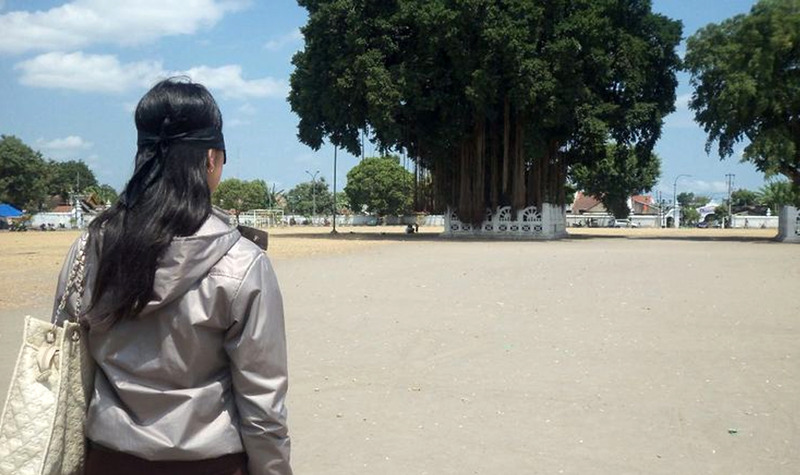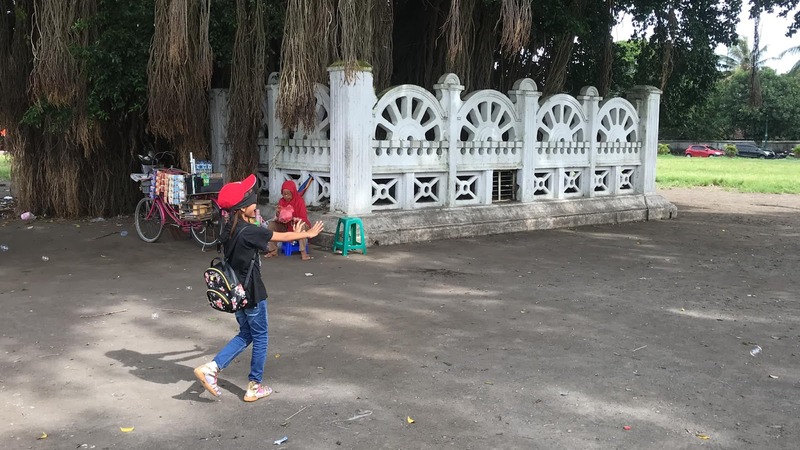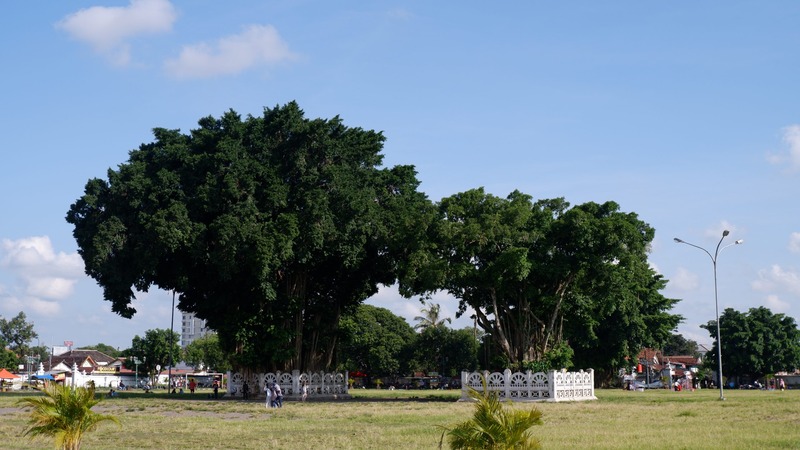Yogyakarta’s wealth of culture sparks interest and curiosity in the wandering souls of the world. Stories of Yogyakarta’s past linger amongst modernity, nonetheless, they never fail to be embraced by any walks of life.
As someone who was born in Yogyakarta yet has spent the majority of her life abroad, hold onto me and allow your rationality to take a step backwards concerning Yogyakarta’s myths - especially the notable Masangin tradition carried out in Alun-Alun Kidul Yogyakarta.
What’s exceptional about Masangin anyway? It’s a tradition correlating to the myth of the Twin Banyan Trees in the middle of the square, which holds sacredness to the people of Yogyakarta and is an essential heritage activity for outsiders to dwell in.
Trying Yogyakarta’s Masangin Tradition
About the Masangin tradition
For newbies to Yogyakarta, the Kraton Ngayogyakarta (Yogyakarta Palace) is flanked by two squares called Alun-Alun Utara (North Square) and Alun-Alun Kidul (South Square). Twin banyan trees inhibit the centres of both squares, stately cast into the blue sky in all lushness and branches slapping in every direction.
I thought I should mention their ages. They have seen it all - the stories from tour guides you meet along your travels about Yogyakarta’s struggles and triumphs under generations of Sultans.
The twins in the South are considered the most pious. Masangin, in rough translation, means "entering between two banyan trees". This tradition requires you to walk straight with your eyes closed, passing two large banyan trees in the middle of Alun Alun Kidul.
Sounds simple, doesn’t it? Not exactly. Many have failed to pass between the twins. Believe it or not, only those with a clean heart and a clear mind can succeed.
You are invited to reflect on yourself and cleanse your heart of bad intentions through this tradition. Failure to pass the twin banyan trees can be a reflection of the remaining negativity that needs to be dealt with in yourself. In a broader context, this tradition teaches the values of honesty, sincerity, and cleanliness of one's heart relevant to daily life.
Myth of the twin banyan trees

Children have been narrated by their grandparents and their grandparents and their grandparents from the very first ears of hearing otherworldly tales relating to the history and myths of the Yogyakarta Palace, as well as the beliefs of their communities.
The banyan tree in Javanese culture symbolises strength, eternity, and protection. Sultan Hamengkubuwono I, the founder of the Yogyakarta Palace, thus planted these twin banyan trees named Kyai Daru and Nyai Daru to serve as the supernatural guardians of the Yogyakarta Palace, holding some sort of magical powers that can determine whether a person has good or bad intentions.
Over time, locals rooted deeper beliefs in the twins’ magical powers. Some said a talisman to repel reinforcements to drive away enemies exists in the centre of the tree.
Alun-Alun Kidul itself is an important part of the palace complex, used for various royal activities and a training ground for palace soldiers. During war times, enemies crossing between the banyan trees would instantly lose their strength. Others were convinced that they could resist opposing armies if only they managed to successfully walk through the straight line. Nonetheless, they practised their concentration by walking between the trees with their eyes closed.
Give Masangin a shot!

Do you reckon that you have great concentration? Do you consider yourself spiritually stable?
You could say the Masangin tradition is a kind of spiritual test. Whoever succeeds in completing the walk with their eyes closed will have their wishes granted. However, if failure bites back, a moment of self-reflection and cleansing of the heart and mind from bad intentions must be implemented.
The Masangin tradition is also an interesting tourist attraction in Yogyakarta. Many local and foreign tourists come to Alun-Alun Kidul to take on this challenge. Somehow, I joined the hype.
The year was 2022. I was on my daily walk around Alun-Alun Utara. The morning was calm and inviting, with the sun casting an orange glow against the dispersing high sunlit clouds. My legs strode away to an unexpected turn after completing two laps around the square. It wasn’t until an intersection I came to my senses that I took an unexpected turn towards the south.
Time was on my side, and I couldn’t figure out any possible reason to divert from my usual route. So I went on, following road signs leading up to Alun-Alun Kidul, declining becak (trishaw) rides offered by several drivers.
The crowd at the square made of sand and grass had a life of its own, intertwining with the air of mysticism or the joys of exploration, depending on one’s viewpoint at that time. I shadowed the invitation of men waving blindfolds in the air. Mothers, fathers, and children eagerly listened to the men explaining the process until their eyes were completely blindfolded.
“Miss, would you like to give Masangin a shot?” asked a man who swayed before me. I had heard about the fuss from my mother, who had succeeded at least once in her youth, but I had never shown any interest in testing it myself. That interest astonishingly grew fonder on that spot, just as how the man who offered me a blindfold popped out of nowhere.
He fastened the blindfold to the point I had no choice but to make acquaintance with darkness. “Can you see anything?” he asked. “Absolutely nothing,” I softly replied.
“Concentrate and walk straight from this spot towards the twin banyan trees. I will be around you to ensure you don’t harm yourself.” A deep inhale and an even deeper exhale later, I started footing it.
Everyone there but me knew exactly how “straight” I went on. Yet, I felt myself clumping; I stopped to regain my concentration. “This way feels right,” redirecting my body.
Soon, that man’s familiar voice echoed closer, “Stop, miss! You’ve made it!” He unfastened the blindfold, “You would’ve tripped over this branch if you continued.”
The brilliant light of day once again was clear to me. I tilted my head up, left to right, immersing the luscious emerald as I stood just over the twins, where a small sign to indicate one’s completion hung through the soft breeze.
Although the blindfolded stroll seems easy, many people actually deviate and do not manage to pass. Many are surprised when they fail on their first try, to the extent of repeatedly trying every time they visit Yogyakarta.
The reasons vary; possibly because of one’s concentration, balance, and peace of mind. This tradition teaches you to focus and maintain balance, both physically and spiritually.
Some believe in the magical power of these two trees as if they "choose" who can pass through them by looking at their purity of heart and good intentions. Moreover, the diverse noises and movements of people around make a person lose orientation, so they fail to reach the gap between the trees.
Regardless of what you believe, we have a few tips for you:
Count your steps
Relieve your nervousness
Maintain your concentration so that you can walk straight
Practice walking straight before trying with your eyes closed
Successfully passing the twins gives an ounce of satisfaction and spiritual achievement. I felt that way, enthusiastically announcing to my family that I had succeeded to their amazement as soon as I finished my daily walk. Fingers crossed that all of my wishes are coming true.
Would you try the Masangin tradition in Yogyakarta?




 Mirella Pandjaitan
Mirella Pandjaitan
 Oct 03, 2024
Oct 03, 2024